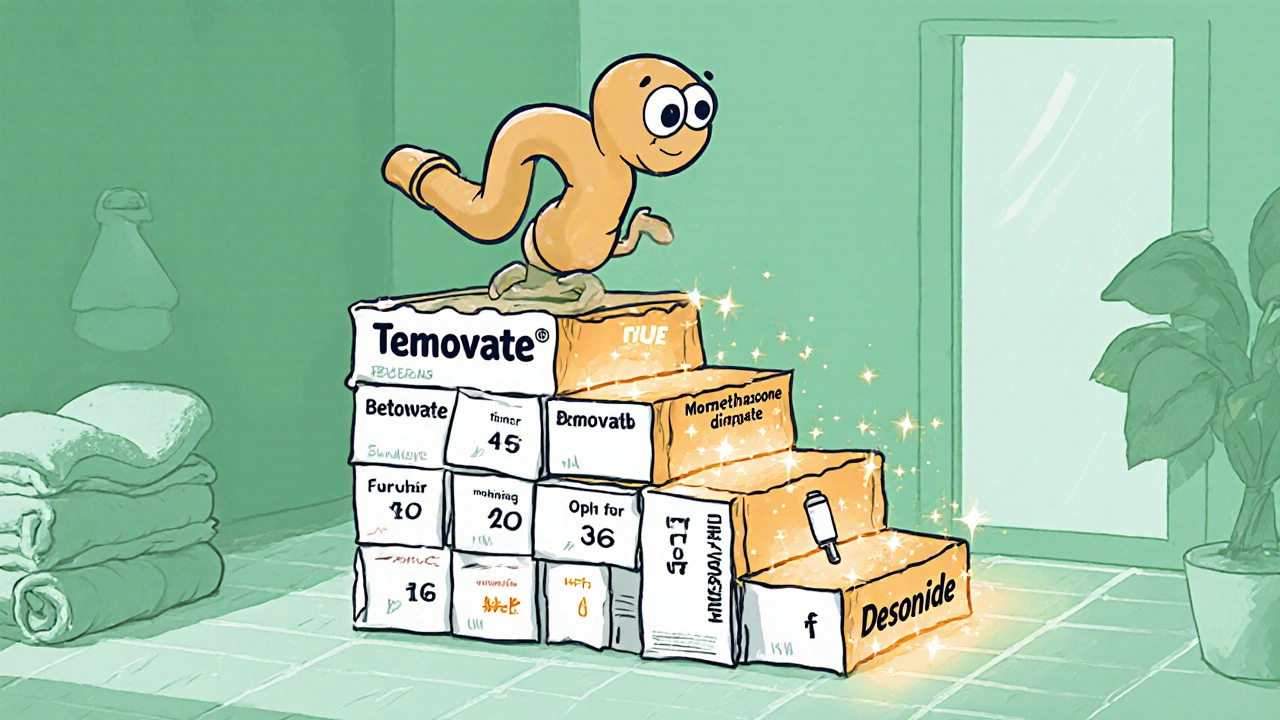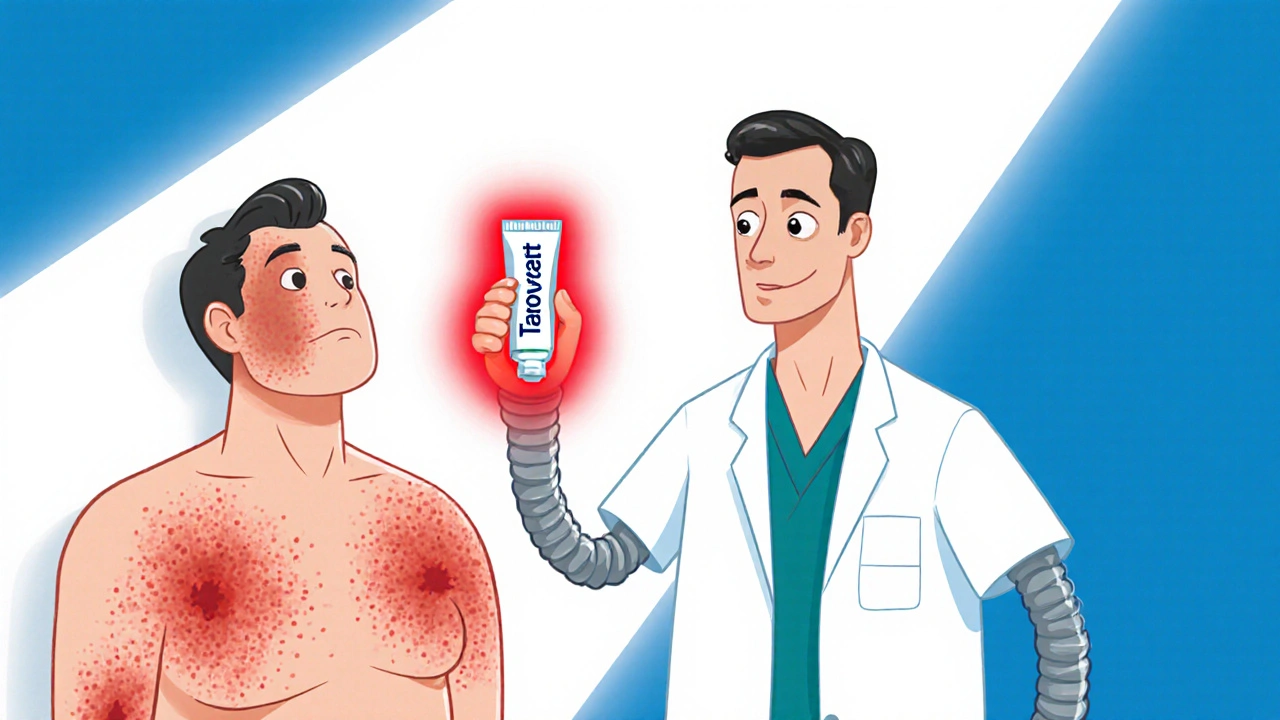Topical Steroid Alternative Calculator
Find Your Best Topical Steroid Alternative
Recommended Alternatives
Top Options
Key Considerations
Side Effect Risk Profile
When you’re battling stubborn eczema, psoriasis or other inflammatory skin conditions, Temovate (known generically as Clobetasol propionate) is often the go‑to prescription. But its high potency can be a double‑edged sword - side effects like skin thinning or adrenal suppression become real concerns if you use it long‑term.
That’s why many patients and clinicians start looking for Temovate alternatives. The market offers a range of steroids that vary in strength, formulation and safety profile. This guide walks you through the most common substitutes, how they stack up against Temovate, and practical tips for switching safely.
How Temovate Works - Potency and Pharmacology
Clobetasol propionate is a super‑potent, class‑I topical corticosteroid. Its molecular structure allows deep penetration into the epidermis, where it binds glucocorticoid receptors and suppresses the release of inflammatory mediators such as prostaglandins and cytokines. In clinical trials, a 0.05% cream achieved a 90% reduction in plaque psoriasis severity after just two weeks of daily use.
Because of that power, Temovate is reserved for severe, recalcitrant lesions, usually applied once or twice daily for a limited period (often two to four weeks). The American Academy of Dermatology warns that continuous use beyond eight weeks raises the risk of atrophy, telangiectasia, and hypopigmentation.
Why Look for Alternatives?
- Safety concerns: prolonged exposure to class‑I steroids can thin the skin and affect the hypothalamic‑pituitary‑adrenal (HPA) axis.
- Cost and insurance coverage: Temovate is brand‑name and can be pricey without prescription benefits.
- Application preferences: some patients dislike the greasy feel of the cream or need a formulation that works under bandages.
- Specific condition needs: certain dermatoses respond better to mid‑strength steroids.
Choosing the right alternative means balancing potency with safety, and matching the formulation to the body area you’re treating.
Common Alternatives - Overview
Below are the most frequently prescribed steroids that clinicians consider when stepping down from Temovate. Each entry includes the drug’s class, typical potency rank (1 = super‑potent, 7 = mild), and a brief usage note.
- Desonide - Class VII (mild). Ideal for delicate areas like the face or intertriginous zones.
- Betamethasone dipropionate - Class II (potent). Good for thick plaques on elbows, knees, or scalp.
- Halobetasol propionate - Class I (super‑potent) but with a slightly lower systemic absorption profile than clobetasol.
- Fluocinonide - Class I (super‑potent) - often prescribed for severe psoriasis.
- Mometasone furoate - Class III (moderately potent). Frequently used for chronic eczema.
- Triamcinolone acetonide - Class IV (mid‑strength). Versatile for a range of inflammatory skin disorders.
- Hydrocortisone - Class VII (mild). Over‑the‑counter option for minor irritations.
Side‑Effect Profile Comparison
| Drug | Potency Class | Typical Indications | Key Side Effects | Prescription Status (US) |
|---|---|---|---|---|
| Temovate (Clobetasol propionate) | 1 (super‑potent) | Severe plaque psoriasis, resistant eczema, lichen planus | Skin atrophy, telangiectasia, HPA‑axis suppression | Prescription |
| Halobetasol propionate | 1 | Psoriasis, hypertrophic scars | Similar to clobetasol but slightly lower systemic absorption | Prescription |
| Fluocinonide | 1 | Severe eczema, psoriasis, discoid lupus | Skin thinning, stretch marks, possible glaucoma with ocular use | Prescription |
| Betamethasone dipropionate | 2 (potent) | Psoriasis, dermatitis, scalp conditions | Moderate atrophy risk, burning sensation | Prescription |
| Mometasone furoate | 3 (moderately potent) | Chronic eczema, atopic dermatitis | Less atrophy, occasional itching | Prescription (OTC in some countries) |
| Triamcinolone acetonide | 4 (mid‑strength) | Inflammatory dermatitis, allergic reactions | Minimal systemic effects, mild skin irritation | Prescription |
| Desonide | 7 (mild) | Periorbital dermatitis, infantile eczema | Very low atrophy risk, safe for face | Prescription (OTC in some regions) |
| Hydrocortisone | 7 (mild) | Minor irritations, insect bites | Negligible systemic risk | OTC |

Pros and Cons - Temovate vs Its Top Competitors
Temovate (Clobetasol)
- Pros: Highest potency, rapid clearance of severe lesions, widely studied.
- Cons: Highest risk of skin atrophy, requires strict prescribing controls, often more expensive.
Halobetasol propionate
- Pros: Comparable potency with slightly lower systemic absorption; available in ointment and foam forms.
- Cons: Still a class‑I steroid, so long‑term use needs monitoring.
Betamethasone dipropionate
- Pros: Potent enough for most plaque psoriasis, easier to taper off.
- Cons: Slightly less effective for ultra‑thick plaques; may cause burning.
Mometasone furoate
- Pros: Good balance of potency and safety; can be used on larger body surfaces.
- Cons: May take longer (2‑4 weeks) to see full effect.
Desonide & Hydrocortisone
- Pros: Very safe for face, genitals, intertriginous zones; OTC options exist.
- Cons: Insufficient for severe plaques; often need adjunct therapy.
When to Consider Switching from Temovate
- Improved lesion control - If plaques have flattened and inflammation is low, start a taper.
- Visible side effects - Early signs of thinning or striae warrant a downgrade.
- Long‑term treatment plan - For chronic maintenance, a mid‑potency steroid reduces cumulative risk.
- Cost or insurance limitations - Switching to a generic alternative can cut out‑of‑pocket expenses.
In practice, dermatologists often use a “step‑down” protocol: 2‑3 weeks of Temovate, then 4‑6 weeks of Betamethasone dipropionate, followed by 8‑12 weeks of Mometasone furoate, finally moving to a low‑potency agent like Desonide for flare‑ups.
How to Transition Safely
- Consult your prescriber before any change - they’ll tailor the taper based on body surface area treated.
- Apply the new steroid to clean, dry skin and avoid occlusion unless advised.
- Monitor for rebound - temporary worsening can happen; keep a symptom diary.
- Use emollients (e.g., ceramide‑rich creams) to support barrier function during the switch.
- Schedule follow‑up within 2-4 weeks to assess response and adjust as needed.

Special Populations - What to Know
Pediatrics: Children under 12 years old are more susceptible to systemic absorption. Low‑potency agents like Desonide are preferred, and any use of Temovate must be limited to short bursts (<2 weeks) under specialist supervision.
Pregnancy & lactation: Class‑I steroids are generally avoided. Mometasone furoate (Class III) is considered acceptable for short courses when benefits outweigh risks.
Elderly skin: Thinner dermis makes atrophy more likely. Starting with a mid‑strength steroid and adding moisturizers reduces complications.
Key Takeaways
- Temovate is the most potent topical steroid available; use it only for severe, resistant lesions.
- Halobetasol and Fluocinonide offer similar strength with nuanced differences in absorption.
- Mid‑potency options like Betamethasone dipropionate or Mometasone furoate provide a safer long‑term maintenance path.
- Low‑potency agents (Desonide, Hydrocortisone) are best for sensitive areas and mild flare‑ups.
- Always taper under medical guidance to avoid rebound and minimize side effects.
Frequently Asked Questions
Can I use Temovate on my face?
Generally no. The facial skin is thin and absorbs steroids quickly, so the risk of atrophy and telangiectasia is high. Doctors usually prescribe a low‑potency option like Desonide or Hydrocortisone for facial lesions.
How long is it safe to stay on Temovate?
Most guidelines limit continuous use to 2‑4 weeks for a given body area. If longer treatment is needed, a dermatologist will rotate to a lower‑potency steroid after the initial burst.
Is Halobetasol cheaper than Temovate?
Pricing varies by country and insurance coverage. In the UK, both are prescription‑only, but generic Halobetasol may be slightly less expensive in some pharmacy chains.
Can I switch directly from Temovate to Hydrocortisone?
A direct jump is usually too big a potency drop and can cause rebound inflammation. A step‑down approach (Temovate → Betamethasone → Mometasone → Hydrocortisone) is safer.
Are there non‑steroid options for severe psoriasis?
Yes. Topical vitamin D analogues (calcipotriene), retinoids, and biologic injections are alternatives. They can be used alongside a short‑term steroid burst for faster relief.
Choosing the right steroid isn’t a one‑size‑fits‑all decision. By understanding potency, side‑effect risk, and formulation nuances, you can work with your dermatologist to create a plan that clears your skin without compromising safety.
 Oct, 16 2025
Oct, 16 2025

Michael Kusold
October 16, 2025 AT 02:30Temovate definitely packs a punch, but you gotta watch out for that skin thinning if you leave it on too long. I’ve seen folks switch to betamethasone after a couple weeks and feel better. Just keep an eye on any stretch marks and talk to your doc about tapering.
Jeremy Lysinger
October 17, 2025 AT 07:23Sharp pick! Jumping to a mid‑potency steroid can keep the flare in check without the nasty side effects.
Nelson De Pena
October 18, 2025 AT 12:16Indeed, a step‑down protocol that moves from clobetasol to mometasone often yields sustainable control while preserving barrier function. It’s essential to monitor the lesion’s response weekly and adjust the regimen accordingly.
Wilson Roberto
October 19, 2025 AT 17:10When we consider the skin as a living canvas, the balance between potency and preservation becomes a dance of intention. Temovate’s aggressive action can clear a stubborn plaque, yet it also rewrites the dermal narrative through atrophy. By transitioning to a slightly less invasive agent such as halobetasol, we honor the skin’s resilience while still addressing the inflammatory storm. This measured approach mirrors the concept that strength without restraint can be self‑defeating. Ultimately, the goal is a harmonious equilibrium where healing outpaces harm.
Narasimha Murthy
October 20, 2025 AT 22:03While the article lauds the step‑down strategy, one must acknowledge that many clinical trials lack long‑term data on cumulative steroid exposure. The assumption that a milder agent automatically reduces systemic risk is overly simplistic, especially in extensive body‑surface applications. Moreover, insurance formularies often dictate drug choice, rendering the ideal taper sequence impractical for the average patient.
Samantha Vondrum
October 22, 2025 AT 02:56Thank you for sharing this comprehensive comparison of clobetasol and its alternatives.
Your step‑down algorithm provides a clear roadmap for clinicians seeking to balance efficacy with safety.
I would like to emphasize the importance of patient education when initiating high‑potency topical steroids.
Patients should be made aware of the potential signs of adrenal suppression, such as unexplained fatigue or dizziness.
In addition, proper application techniques-using a fingertip unit and avoiding occlusion unless prescribed-can markedly reduce systemic absorption.
It is also beneficial to incorporate barrier‑repair moisturizers, particularly those containing ceramides, to support epidermal recovery during the taper.
From a pharmacoeconomic perspective, generic formulations of betamethasone dipropionate often present a cost‑effective alternative without compromising therapeutic outcomes.
However, clinicians must verify that the dispensing pharmacy supplies the appropriate vehicle, as ointments versus creams can influence drug penetration.
For pediatric patients, limiting the duration of clobetasol to a maximum of two weeks is prudent, given their higher surface‑area‑to‑body‑mass ratio.
Furthermore, regular follow‑up appointments, ideally every two to three weeks, enable early detection of adverse effects and allow timely adjustments to the regimen.
When transitioning to medium‑potency steroids such as mometasone furoate, a gradual reduction in frequency-e.g., from twice daily to once daily-helps mitigate rebound inflammation.
Clinicians should also consider adjunctive therapies, including topical calcineurin inhibitors, for areas where steroid use is contraindicated.
In my practice, I have observed that patients who maintain a consistent emollient routine experience fewer flare‑ups during the tapering phase.
Lastly, documentation of the taper schedule within the electronic health record facilitates interdisciplinary communication and ensures continuity of care.
I appreciate the thoroughness of this guide and hope it assists both providers and patients in making informed decisions. 😊👍
Kelvin Egbuzie
October 23, 2025 AT 07:50Oh sure, just trust the pharma‑sponsored step‑down plan while they keep churning out patents on ever‑stronger steroids. 🙄
Katherine Collins
October 24, 2025 AT 12:43Looks good but kinda boring. 😐
Taylor Nation
October 25, 2025 AT 17:36We can spice it up by adding a quick skin‑calming routine-like a fragrance‑free probiotic cream-between the steroid switches to keep the barrier happy.
Nathan S. Han
October 26, 2025 AT 22:30In the grand theatre of dermatology, each steroid is a character stepping onto the stage: Temovate bursts forth as the tempestuous hero, while gentler agents like desonide play the soothing chorus that restores harmony after the storm.